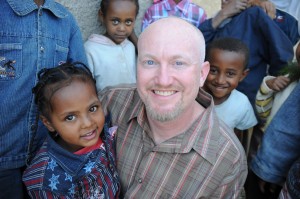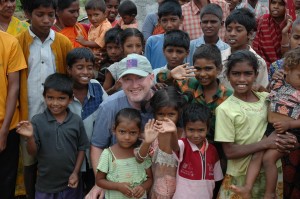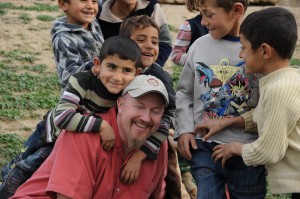 Paul Myhill is an entrepreneur and consultant for social ventures and non-profits. He graduated from BHP in 1989 and earned an MBA from UT in 1991. While at UT he took to heart the motto, “What starts here changes the world,” and he has spent his entire career working to make a significant contribution to the world by creating and collaborating with companies to fund charitable causes that are close to his heart. He is the founder of the Traffic Jam Campaign that rescues children from trafficking and slavery and, most recently, he founded One Percent for Children which enlists companies – primarily start-ups and early-stage ventures – to give one percent of their equity and/or one percent of their annual gross revenues to a variety of pre-selected global causes that impact the safety and wellbeing of children
Paul Myhill is an entrepreneur and consultant for social ventures and non-profits. He graduated from BHP in 1989 and earned an MBA from UT in 1991. While at UT he took to heart the motto, “What starts here changes the world,” and he has spent his entire career working to make a significant contribution to the world by creating and collaborating with companies to fund charitable causes that are close to his heart. He is the founder of the Traffic Jam Campaign that rescues children from trafficking and slavery and, most recently, he founded One Percent for Children which enlists companies – primarily start-ups and early-stage ventures – to give one percent of their equity and/or one percent of their annual gross revenues to a variety of pre-selected global causes that impact the safety and wellbeing of children
How would you describe your unique career path?
I have always had a desire to change the world and make a difference and while I was in BHP and the MBA program, I developed a real love of entrepreneurship. To me success is not monetary, but defined by significance and how much positive change I can create. I wanted to make a significant contribution to the world while pursuing entrepreneurial endeavors. My career has been focused on creating income-producing ventures that can benefit the world through their close association with, and support of, relevant causes and charities. My passion for entrepreneurial pursuits has spanned a host of industries, products, services and business models, both public and private. In all cases, there is a common theme of using the products or services directly, or the income they produce, to help high-impact charitable endeavors. The charitable gifts can come from equity on the front end, a percentage of annual revenues or royalties, an amount based on the attainment of certain performance benchmarks, or any number of other options. As the businesses are successful, the charities they are supporting are also successful. Value is also created for the businesses involved in these programs through increased exposure and goodwill, resulting in greater revenues through better customer attainment and retention.
Tell me more about the causes you are passionate about and what you are working towards with your various involvements in these causes.
 I am passionate about helping orphaned, abandoned, abused and exploited children. My primary goal is to use businesses to fund work that helps children around the world. My involvement first started with orphans in the developing world. I wanted to get them into loving homes in their communities instead of the default institutionalization model or, worse, letting them fend for themselves in slums and sewers. As I was working with these populations of orphaned and abandoned children around the globe, I started to notice them going missing, later finding out that they were being snatched up by human traffickers and sold into the child sex trade. I wanted justice for these kids and to help prevent them from being preyed upon. I realized the need for more prevention and rescue programs, safe houses, and aftercare support – rehabilitation and restoration facilities. Now my goal is to help create a movement of companies to tackle the gross injustices suffered by tens of millions of children around the world through One Percent for Children. I initially started with businesses I founded and consulted with to make an impact. Now I am scaling what I learned through my venture and philanthropic experience to expand for greater outcomes and impact.
I am passionate about helping orphaned, abandoned, abused and exploited children. My primary goal is to use businesses to fund work that helps children around the world. My involvement first started with orphans in the developing world. I wanted to get them into loving homes in their communities instead of the default institutionalization model or, worse, letting them fend for themselves in slums and sewers. As I was working with these populations of orphaned and abandoned children around the globe, I started to notice them going missing, later finding out that they were being snatched up by human traffickers and sold into the child sex trade. I wanted justice for these kids and to help prevent them from being preyed upon. I realized the need for more prevention and rescue programs, safe houses, and aftercare support – rehabilitation and restoration facilities. Now my goal is to help create a movement of companies to tackle the gross injustices suffered by tens of millions of children around the world through One Percent for Children. I initially started with businesses I founded and consulted with to make an impact. Now I am scaling what I learned through my venture and philanthropic experience to expand for greater outcomes and impact.
What has been the most memorable moment of your work so far?
There are memorable moments from all aspects of my life. Getting a product [Protandim] featured on ABC Primetime Live was very memorable. That breakthrough product alone is a legacy creator and that was the proudest moment of my life from a business and product-development standpoint. Likewise, winning the MOOT CORP competition was my greatest memory and proudest achievement from an academic standpoint.
It is hard to pick one on the charitable side. I adopted my daughter from Asia and my heart leaps even more so when we see kids rescued from slavery in Asia. For example, I work with the Vietnamese community in Cambodia, a population that is at high-risk for sex trafficking. It is estimated that thirty-percent of the Vietnamese families in Cambodia have sold a child into the Cambodian sex trade just to survive and pay off debt. On one of the many trips I have taken there, a local teacher pointed out two 12-year old girls and told me their parents were going to sell them the very next week. I was able to immediately make sure that didn’t happen by putting their girls in a skills-development program. We invested in the girls by educating them. We prepared them to be able to produce an income for the family in the future so the parents wouldn’t sell them. I have pictures of those girls on my desk from then and also from when they were 16 and 18. I know that those two girls didn’t have to endure the prostitution, rape and resulting stigma, and that they are now able to help support their families and community. Those kinds of prevention stories are the ones that impact me the most, even more so than the rescues.
You continue to use your business skills to make an impact through non-profit work. Are there any common themes you see in your work with non-profits that are barriers to their success?
One of the problems is a lot of the non-profits are well-intentioned but because they are US-based charities, they have to go through a series of partnership connections to get their money into the field because they aren’t in the field themselves. For example, you might have a non-profit that raises funds, then takes out their administrative fees before they pass the funds on to another non-profit oversees, that also takes out their own administrative fees before they pass it on and so on. By the time it gets to the front-line specialist, there could be four or five levels of administrative fees that were taken out, so only fifty-percent of the original donation is in the field.
We focus on finding the right front-line partners through extensive due diligence and high-accountability systems, to cut out this chain of diminishing applied resources. My non-profits direct 100 percent of public donations to the front-line specialists who are doing the real work. Partnerships with companies to apply equity and revenues to administrative costs enables general public contributions to go straight into the field. One Percent for Children, for example, is a warehouse for getting such funds from businesses, but we also have developed and apply core competencies that have been achieved through the collaboration with child-focused programs in over 75 countries. These competencies include due diligence and accountability in the field, getting funds straight into the hands of front-line practitioners without “middlemen,” and the sharing and implementation of best practices for more effective and lasting outcomes.
You won the UT MOOT CORP competition while you were in school. What was your business plan and did that lead to anything?
It was for advertising sales and placements using the boards that you now see in multiple locations like restrooms, stadiums, elevators, etc. We were one of two companies started at the same time that opened up this whole new concept in advertising. We could sell extremely targeted advertising to captive audiences that were very well defined demographically. When we won the competition with that plan a couple of the judges subsequently invested in the company. All expenses were tied to the revenue and so the costs were completely variable. It was a great business model, but the other teammates had other dreams, so we ran it for a year or so, then passed it on to another operator who now franchises it around the world.
*Note: The UT MOOT CORP competition was the predecessor to the Texas Venture Labs Investment Competition.
What advice do you have for current students?
 The opportunity that you have been given – being part of such a prestigious program – is not only going to embed skills that can be used to make a tremendous difference, but will open many doors to you. As they say, “with great power comes great responsibility” – you are in a program that is truly empowering. Appreciate that, but realize you have a responsibility to use that in ways that can create positive change, and not just earn you money. You will have opportunities that others can only dream of. Define success as significance and truly change the world as you strive for it. Of course, I would encourage you to give to One Percent for Children if you end up creating a new business. How beautiful it would be to see many businesses run by BHP students and alumni coming together to help impact so many children’s lives around the world.
The opportunity that you have been given – being part of such a prestigious program – is not only going to embed skills that can be used to make a tremendous difference, but will open many doors to you. As they say, “with great power comes great responsibility” – you are in a program that is truly empowering. Appreciate that, but realize you have a responsibility to use that in ways that can create positive change, and not just earn you money. You will have opportunities that others can only dream of. Define success as significance and truly change the world as you strive for it. Of course, I would encourage you to give to One Percent for Children if you end up creating a new business. How beautiful it would be to see many businesses run by BHP students and alumni coming together to help impact so many children’s lives around the world.
I also want to stress to you that, for me, it has never been a case of either choosing to go into for-profit or non-profit. With the right motives and plans, there can be a great synergy between the two. You can indeed be in a for-profit making a difference. It doesn’t have to be compartmentalized; they can be tied together in a mutually-beneficial relationship, as platforms of support for each other.
